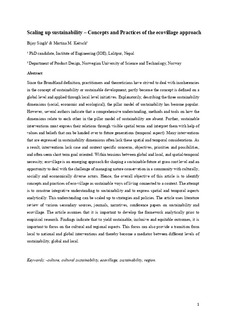| dc.description.abstract | Since the Brundtland definition, practitioners and theoreticians have strived to deal with incoherencies in the concept of sustainability or sustainable development, partly because the concept is defined on a global level and applied through local level initiatives. Explanatorily, describing the three sustainability dimensions (social, economic and ecological), the pillar model of sustainability has become popular. However, several authors indicate that a comprehensive understanding, methods and tools on how the dimensions relate to each other in the pillar model of sustainability, are absent. Further, sustainable interventions must express their relations through visible spatial terms and interpret them with the help of values and beliefs that can be handed over to future generations (temporal aspect). Many interventions that are expressed in sustainability dimensions often lack these spatial and temporal considerations. As a result, interventions lack case‐ and context‐specific concerns, objectives, priorities and possibilities, and often seem short‐term goal‐oriented. Within tensions between global and local, and spatial–temporal necessity, ecovillage is an emerging approach for shaping a sustainable future at grass roots level, and an opportunity to deal with the challenge of managing nature conservation in a community with culturally, socially and economically diverse actors. Hence, the overall objective of this article is to identify concepts and practices of ecovillage as sustainable way of living connected to a context. The attempt is to construe integrative understanding to sustainability and to express spatial and temporal aspects analytically. This understanding can be scaled up to strategies and policies. The article uses a literature review of various secondary sources, journals, narratives, and conference papers on sustainability and ecovillage. The article assumes that it is important to develop the framework analytically prior to empirical research. Findings indicate that to yield sustainable, inclusive and equitable outcomes, it is important to focus on the cultural and regional aspects. This focus can also provide a transition from local to national and global interventions and thereby become a mediator between different levels of sustainability, global and local. | nb_NO |
